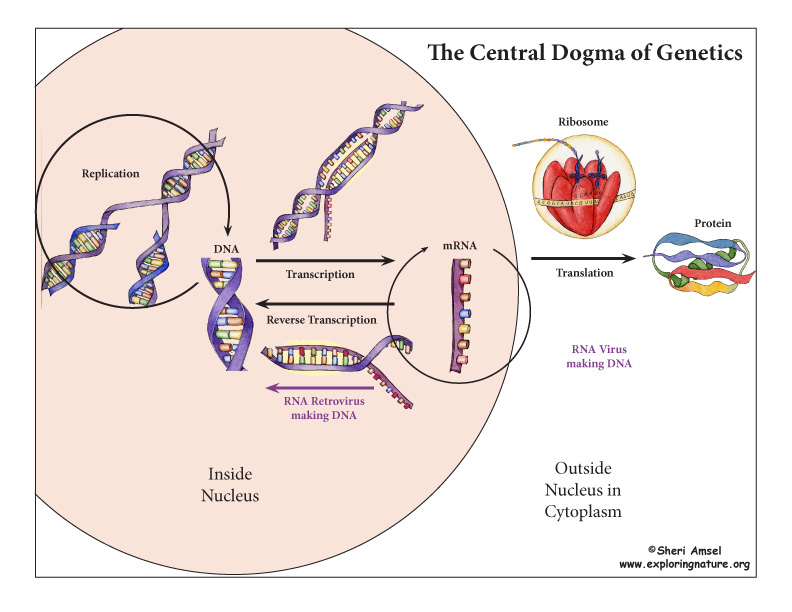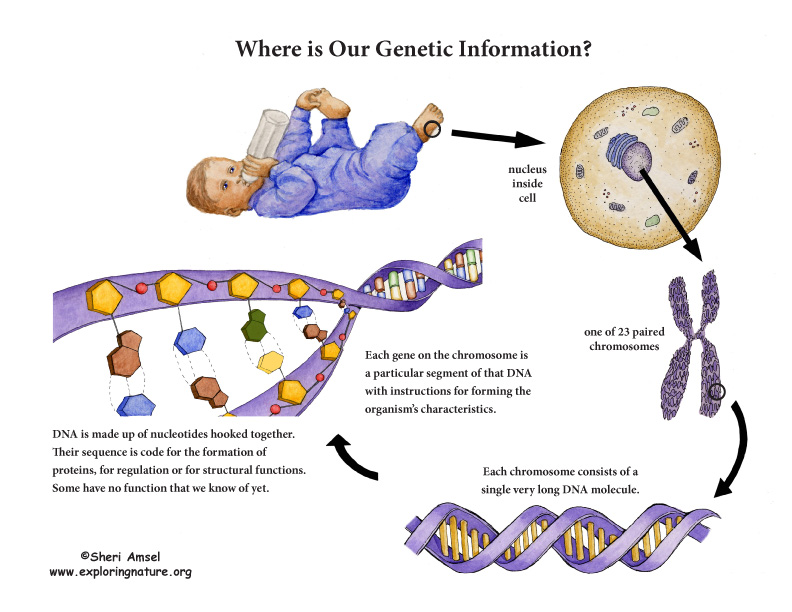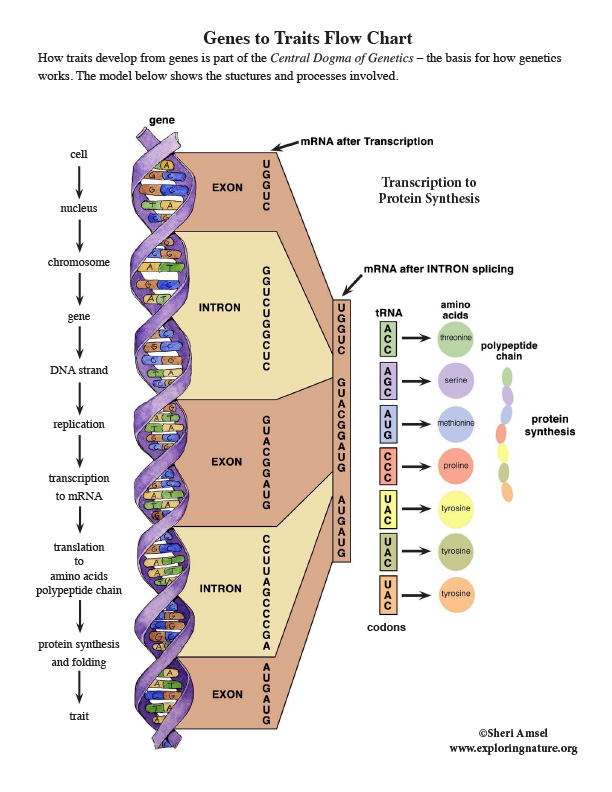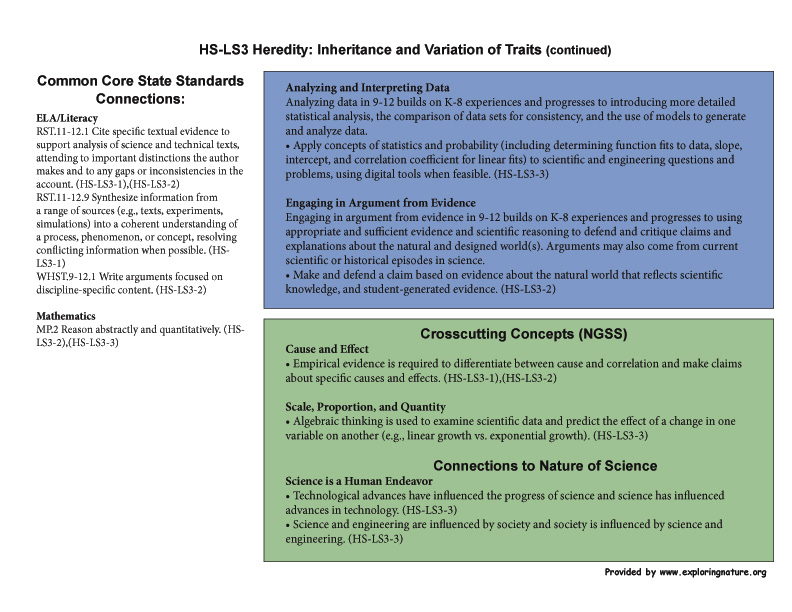


_________________________________________________________________________________________________________________________________________________________
Disciplinary Core Ideas
LS1.A: Structure and Functions
• All cells contain genetic information in the form of DNA molecules. Genes are regions in the DNA that contain the instructions that code for the formation of proteins. (secondary to HS-LS3-1) (Note: This Disciplinary Core Idea is also addressed by HS-LS1-1.)
LS3.A: Inheritance of Traits
• Each chromosome consists of a single very long DNA molecule, and each gene on the chromosome is a particular segment of that DNA. The instructions for forming species’ characteristics are carried in DNA. All cells in an organism have the same genetic content, but the genes used (expressed) by the cell may be regulated in different ways. Not all DNA codes for a protein; some segments of DNA are involved in regulatory or structural functions, and some have no as-yet known function. (HS-LS3-1)
LS3.B: Variation of Traits
• In sexual reproduction, chromosomes can sometimes swap sections during the process of meiosis (cell division), thereby creating new genetic combinations and thus more genetic variation. Although DNA replication is tightly regulated and remarkably accurate, errors do occur and result in mutations, which are also a source of genetic variation. Environmental factors can also cause mutations in genes, and viable mutations are inherited. (HS-LS3-2)
• Environmental factors also affect expression of traits, and hence affect the probability of occurrences of traits in a population. Thus the variation and distribution of traits observed depends on both genetic and environmental factors. (HS-LS3-2),(HS-LS3-3)
Performance Expectations
Students who demonstrate understanding can:
HS-LS3-1. Ask questions to clarify relationships about the role of DNA and chromosomes in coding the instructions for characteristic traits passed from parents to offspring. [Assessment Boundary: Assessment does not include the phases of meiosis or the biochemical mechanism of specific steps in the process.]
HS-LS3-2. Make and defend a claim based on evidence that inheritable genetic variations may result from: (1) new genetic combinations through meiosis, (2) viable errors occurring during replication, and/or (3) mutations caused by environmental factors. [Clarification Statement: Emphasis is on using data to support arguments for the way variation occurs.] [Assessment Boundary: Assessment does not include the phases of meiosis or the biochemical mechanism of specific steps in the process.]
HS-LS3-3. Apply concepts of statistics and probability to explain the variation and distribution of expressed traits in a population. [Clarification Statement: Emphasis is on the use of mathematics to describe the probability of traits as it relates to genetic and environmental factors in the expression of traits.] [Assessment Boundary: Assessment does not include Hardy-Weinberg calculations.]
_________________________________________________________________________________________________________________________________________________________
Use the Template and Resource Links to Fulfill NGSS
l. Goals:
Essential Questions:
NGSS Note: Think, question, entertain ideas.
ll. Introductory Activities to Assess Prior Knowledge
A. Simple Activities - that assess students’ understanding of the topic. Supplement with your own assessment activities.
Genetic Code Structures - Labeling
Name the Processes and Structures of the Central Dogma of Genetics
DNA, Chromosomes, and Genes - Short Answer Quiz
Simple Activities - that assess students’ understanding of traits.
Make a flow chart from chromosome to trait (like hair color), including naming all the processes along the way.
B. Brainstorming Sessions
Question: Can you make a flow chart starting with the cell down to the gene and then to a physical trait? What are the structures and processes involved in the coding for a human trait like hair color?
1. Break students down into groups of 3-4.
2. Ask students to generate a flow chart starting with the cell down to the gene and then to a physical trait. Don't forget to add any of the processes, like transcription, along the way.
3. Discuss using the Genes to Traits Flow Chart and RNA Translation in the diagrams below.
lll. New Knowledge - Text
A. Read about:
The History of Genetics - How Animals Were Domesticated
The History of Genetics - How Wild Plants Were Domesticated
Gregor Mendel's Genetics Discoveries with Peas
Predicting Genetics Traits - The Punnett Square
Genetics Activity - Create The Kids
Using Punnett's Square to Show Mendel's Genetics Discoveries
Crossing Over - Variation of Traits in Humans
Gene Expression and Regulation
Genetic Engineering and Agriculture
The Genetic Code – What Exactly is it?
The Important Role of Proteins in… Everything
Watson and Cricks Great Discovery - The Structure of DNA
Recombination - Creating More Genetic Variation
Variation of Traits Reading, Diagram, and Critical Thinking
B. Examples of Models (depicts the concept expressed in the reading):
Ask students to look at the models and explain how each illustrates the concepts they read about.
lV. Experiments, Activities, Model-making (Critical Thinking)
A. Critical Thinking Activities related to this topic:
Inheritance and Variation of Traits in Caribou Herds - Authentic Performance
Traits and Characteristics - Critical Thinking Activity
Genetics Activity - Create The Kids
V. Summarize Knowledge - Enduring Understandings
Vl. New Generation of Science Standards (NGSS) - High School Life Science
Disciplinary Core Ideas
LS1.A: Structure and Functions
• All cells contain genetic information in the form of DNA molecules. Genes are regions in the DNA that contain the instructions that code for the formation of proteins. (secondary to HS-LS3-1) (Note: This Disciplinary Core Idea is also addressed by HS-LS1-1.)
LS3.A: Inheritance of Traits
• Each chromosome consists of a single very long DNA molecule, and each gene on the chromosome is a particular segment of that DNA. The instructions for forming species’ characteristics are carried in DNA. All cells in an organism have the same genetic content, but the genes used (expressed) by the cell may be regulated in different ways. Not all DNA codes for a protein; some segments of DNA are involved in regulatory or structural functions, and some have no as-yet known function. (HS-LS3-1)
LS3.B: Variation of Traits
• In sexual reproduction, chromosomes can sometimes swap sections during the process of meiosis (cell division), thereby creating new genetic combinations and thus more genetic variation. Although DNA replication is tightly regulated and remarkably accurate, errors do occur and result in mutations, which are also a source of genetic variation. Environmental factors can also cause mutations in genes, and viable mutations are inherited. (HS-LS3-2)
• Environmental factors also affect expression of traits, and hence affect the probability of occurrences of traits in a population. Thus the variation and distribution of traits observed depends on both genetic and environmental factors. (HS-LS3-2),(HS-LS3-3)
Science and Engineering Practices (NGSS)
Asking Questions and Defining Problems
Asking questions and defining problems in 9-12 builds on K-8 experiences and progresses to formulating, refining, and evaluating empirically testable questions and design problems using models and simulations.
• Ask questions that arise from examining models or a theory to clarify relationships. (HS-LS3-1)
Asking Questions and Defining Problems
Analyzing data in 9-12 builds on K-8 experiences and progresses to introducing more detailed statistical analysis, the comparison of data sets for consistency, and the use of models to generate and analyze data.
• Apply concepts of statistics and probability (including determining function fits to data, slope, intercept, and correlation coefficient for linear fits) to scientific and engineering questions and problems, using digital tools when feasible. (HS-LS3-3)
Engaging in Argument from Evidence
Engaging in argument from evidence in 9-12 builds on K-8 experiences and progresses to using appropriate and sufficient evidence and scientific reasoning to defend and critique claims and explanations about the natural and designed world(s). Arguments may also come from current scientific or historical episodes in science.
• Make and defend a claim based on evidence about the natural world that reflects scientific knowledge, and student-generated evidence. (HS-LS3-2)
Crosscutting Concepts (NGSS)
Cause and Effect
• Empirical evidence is required to differentiate between cause and correlation and make claims about specific causes and effects. (HS-LS3-1),(HS-LS3-2)
Scale, Proportion, and Quantity
• Algebraic thinking is used to examine scientific data and predict the effect of a change in one variable on another (e.g., linear growth vs. exponential growth). (HS-LS3-3)
Performance Expectations
Students who demonstrate understanding can:
HS-LS3-1. Ask questions to clarify relationships about the role of DNA and chromosomes in coding the instructions for characteristic traits passed from parents to offspring. [Assessment Boundary: Assessment does not include the phases of meiosis or the biochemical mechanism of specific steps in the process.]
HS-LS3-2. Make and defend a claim based on evidence that inheritable genetic variations may result from: (1) new genetic combinations through meiosis, (2) viable errors occurring during replication, and/or (3) mutations caused by environmental factors. [Clarification Statement: Emphasis is on using data to support arguments for the way variation occurs.] [Assessment Boundary: Assessment does not include the phases of meiosis or the biochemical mechanism of specific steps in the process.]
HS-LS3-3. Apply concepts of statistics and probability to explain the variation and distribution of expressed traits in a population. [Clarification Statement: Emphasis is on the use of mathematics to describe the probability of traits as it relates to genetic and environmental factors in the expression of traits.] [Assessment Boundary: Assessment does not include Hardy-Weinberg calculations.]
When you research information you must cite the reference. Citing for websites is different from citing from books, magazines and periodicals. The style of citing shown here is from the MLA Style Citations (Modern Language Association).
When citing a WEBSITE the general format is as follows.
Author Last Name, First Name(s). "Title: Subtitle of Part of Web Page, if appropriate." Title: Subtitle: Section of Page if appropriate. Sponsoring/Publishing Agency, If Given. Additional significant descriptive information. Date of Electronic Publication or other Date, such as Last Updated. Day Month Year of access < URL >.
Amsel, Sheri. "LS3.A: Inheritance of Traits, LS3.B: Variation of Traits, LS1.A: Structure and Function (HS - LS3 Heredity, LS1 From Molecules to Organisms)" Exploring Nature Educational Resource ©2005-2024. December 14, 2024
< http://www.exploringnature.org/db/view/LS1A-Structure-and-Function-LS3A-Inheritance-of-Traits-LS3B-Variation-of-Traits-HS-LS3-Heredity >






